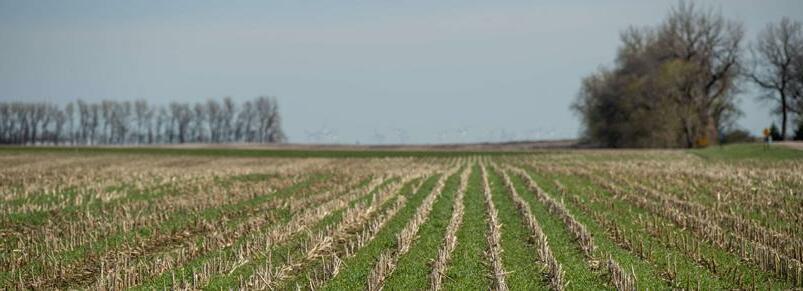
8 minute read
Small Changes
from 2022 Early Summer
by MilkProducer
SMALL CHANGES ADD UP
Sustainability on the farm doesn’t have to mean new equipment or biodigesters — everyday action and small decisions add up to big results
By Lyndsey Smith
FOR ALL THE RESPONSIBILITY FARMERS CARRY FROM DAY-
TO-DAY, care for the environment at first glance can seem like a very large ask. However, farmers have already incorporated many changes to address greenhouse gas emissions, nutrient movement off-farm, and habitat preservation. What’s more, there are plenty of small steps farmers can do right now or this season on individual farms that add up to big changes — and nearly all add to the bottom line, too. Taking care of the soil, water, and air benefits all — including the bottom line (economic sustainability is one of the three pillars of sustainability). On Janet Harrop’s dairy farm near Fergus, ON, finetuning the nutrient management strategy has saved the farm money and has reduced the risk of excess nutrients entering waterways.
NUTRIENT MANAGEMENT
Using the AgriSuite program through the Ontario Ministry of Agriculture, Food and Rural Affairs, Harrop says the farm has balanced manure applications on each field with added fertilizer to meet the crop’s needs but not exceed what the soil can hold, minimizing the risk of loss or over-fertilizing. “About 60 per cent of the dairy cows in Ontario are under a nutrient management plan, so a lot of farmers are already doing this work,” she says. On her farm, they’ve also added the practice of growing a cover crop after harvest to keep the soil protected and hold nutrients in place. Harrop says the added side benefit of significant weed reduction because of the cover crop practice has been an excellent bonus. The farm is also decreasing the amount of tillage it uses, and the combination of more intensive nutrient management planning and cover cropping is resulting in both measurable and intangible benefits, Harrop says. “I did soil sampling four years apart, and we saw a significant increase in organic matter and a positive change in pH,” she says. The added organic matter supports yield, and acts like a sponge during rain events, creating more resilient soils in big rain events, and more water holding capacity for dry spells. Reducing tillage has also meant fewer hours in the tractor, and that’s saved on diesel fuel use and the resulting emissions, all while maintaining or even improving crop yield.
LESS FEED, MORE FOOD
Farmers have always been master re-users, and, with the help of livestock, plenty of food cast-offs are being turned in to nutrientdense food for humans.
For example, beef, sheep, and dairy farmers make use of brewer’s grains (left over from the beer brewing process) to feed livestock, diverting this waste from landfills. Fruit and bakery “waste” is still food — just not for humans. Cattle and sheep take these odds and ends and turn them into meat and milk. Many processors and brewers are looking for cost-effective ways to deal with waste; a phone call or a meeting may be all you need to do to take advantage of a new low-cost feed source.
But making use of waste food is only part of the solution. On Harrop’s farm, calves are genotyped at birth so that they know well ahead of the animal’s productive life whether or not they are making steps toward animals that require less feed. “When our cows are eating less, or require less feed to produce the
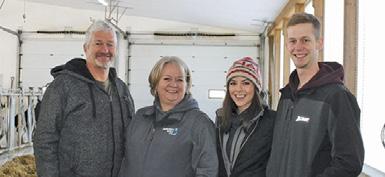
Janet Harrop farms with her family near Fergus, ON.
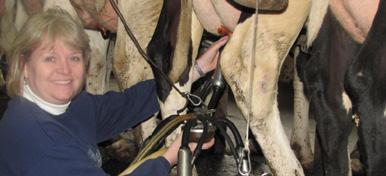
same amount of milk, that reduces greenhouse gases,” Harrop says. Over thousands of animals every year, these small, incremental gains really add up to big reductions in emissions. Not all farmers have the advantage that dairy farmers have of genetic data to select for animals that will make the most of feed, and so good record keeping can be a small way to make big changes in the long term. Even without genotyping, measuring weight gain against feed used can help identify which animals’ lineage is more efficient. The reduced emissions from thriftier animals translates to better margins for farmers, too.
THE LITTLE THINGS
Not all changes have to be large-scale or expensive to address key environmental concerns. Here are a few quick things you can do or habits you can adopt today that add up to big impacts.
• Check all water sources. Drips and leaks can add up to huge volumes over time. Check all taps, hoses, and connections for leaks and fix immediately. Need to offer water? On-demand systems use less, and reduce evaporation. Set up any exterior water sources on a float system.
• Reduce plastic packaging. Buy in bulk, if you can, and return/reuse containers.
• Stop idling. Unless it’s very cold or very hot, does that engine really need to be running? Get in the habit of turning off equipment and vehicles.
• Remember that sustainability includes community, too. Make sure you’re taking care of yourself — volunteering is a great way to give back to the community and get a much needed break from every day at the farm.
PLASTIC WASTE
There are still many challenges ahead for recycling farm plastics. That said, there are still opportunities to make a difference in the amount of plastic waste the farm produces. In the three Rs, the first
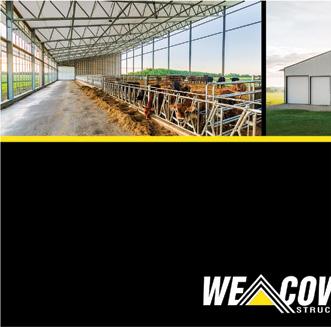
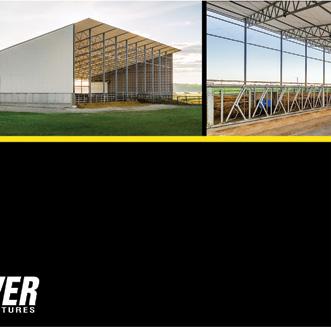
R is “reduce.” Take a look at every step of the food production process and assess if there is a way to reduce the amount of packaging or single-use plastic. Look at every facet of the farm — from your own use in the house or field, to the containers in the barn or supplies used for feed. Once you’ve reduced the total amount of plastic, it’s time to identify a second life for as much of the unrecyclable plastic as possible. Totes for hay preservative or other products, once cleaned, can make great water totes for gardens or livestock, or even pens for kids and lambs at a neighbour’s. Silage plastic or bale wrap can find a second home at a market garden as weed suppression. The key here is finding a new life at a new farm, as your own may not have a means to re-use it. Recycling plastic is a great option, but isn’t available in all counties or regions, or for all types of plastic. Contact your local waste management organization to determine what kinds of plastics can be recycled, and continue to push for better recycling options of products such as bale wrap or twine.

DO SOMETHING, SAY SOMETHING
If you’re frustrated by farmers shouldering the brunt of environmental finger-pointing, remember that pictures speak louder than words, and that our customers don’t usually get to see a farm or meet a farmer. Take a walk around your farm with a critical eye — is there a field margin that never really produces well that would be better suited to perennial cover that doubles as pollinator habitat? Seed it down, then get some photos. Share those photos on social media or with your local community to let customers know you’re doing the good work. Explain why you make the decisions you do, and share the concerns you have about soil health, clean water, and clean air. Customers want to know that farmers share the same values.
Have you found a great new way to re-use plastic and keep it out of landfills? Share your solution with others, and make sure to let the world know that you’re finding small ways to make a big difference. Cover crops, fall-planted crops, perennial cover, or delayed-cut hay all contribute to bird, small mammal, and insect habitat. If you use any of these practices, snap a photo of the butterflies you see or the bird nests you find: what is a common site for you is a wonder to someone else. If you see something neat, share it!
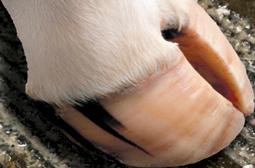
AGRI-TRAC Milled our dairy barn floors in August of 2000.22 Years later we just had AGRI-TRAC backto do them again. It lasted 22 Years! We chose Over 25 Y Years AGRI-TRAC bothtimesinstead of grooving because it works and lasts. We have experience, grooving does NOT work! Thank you AGRI-TRAC. Providing Permanent Traction forfarmers thatlastsdecades! Mario Vriens Friendly Farms Arthur, ON 877-966-3546 www.agritraction.com
AGRI-TRAC gives• Increase milk production • Increase heat detection • Reduce hoof and leg injuries • Reduce cull rates thecows without being too aggressive AGRI-TRAC gives the cows the traction they need without being too aggressive Over 25 Years like how theAGRI-TRAC milled our dairy barn floors in August of 2000. floor is easy to on their feet. We also like how the floor is easy to scrape and clean. Providing 22 years later we just had AGRITRAC back to do them again. James Wa James Walker, Walkerbrae Farms Guelph, ON Permanent Traction It lasted 22 Years! We chose AGRI-TRAC both times for farmers instead of grooving because it works and lasts. Thank you AGRI-TRAC. that lasts decades! Mario Vriens, Friendly Farms, Arthur, ON
www.agritractions.com 1-877-966-3546

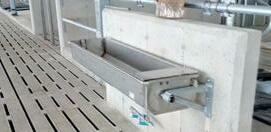
MICHAEL’S STABLING DEVELOPMENTS INC.
Manufacturer of all types of milking parlor frames
• Parabone • Herringbone • Parallel • Rapid Exit • Tandem style • Also custom orders
• Self lock head gates • Pro free stalls • Slant stalls and gates • Calf pens • Tie stalls • Tip tanks
519-794-3933
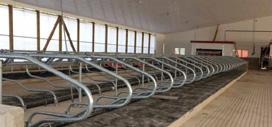
High performance, low maintenance stabling solutions that will benefit you and your livestock each and every day.




